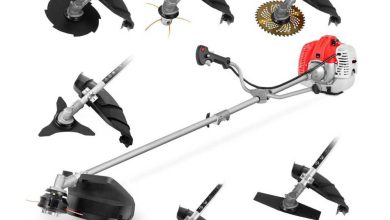Caterpillars in the Garden: What are they? How do we identify them? How do we combat them?
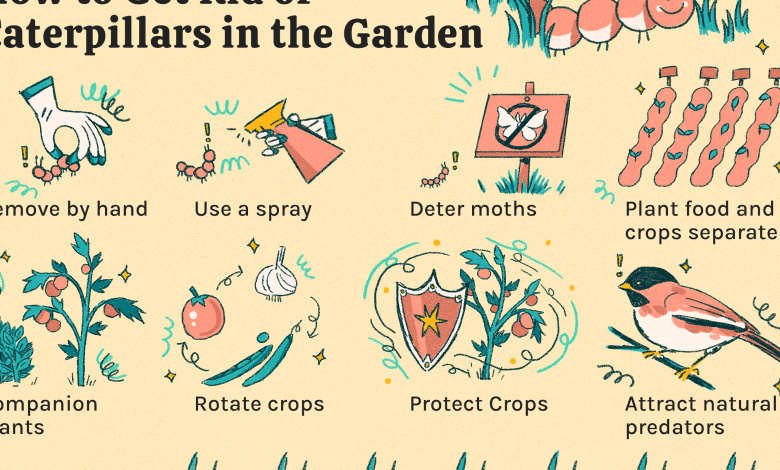
There are several species of caterpillars that affect crops and orchards, some very different from each other, but all of them with a great potential for damage, since they feed on roots, shoots or shoots of herbaceous plants.
Caterpillars belong to the Lepidoptera family. They have an elongated and cylindrical body divided into segments.
They have six legs and several pairs of false legs.
The main difference between species is seen in the number of false abdominal legs (for example, Spodoptera and Heliothis species have five pairs of false legs, while species such as Autographa and Chrysodeisis have only two).
Other characteristics such as silks on the body, coloration, shape of the head or pairs of eyes allow different species to be distinguished.
Even so, their biology is quite similar, going through egg stages, between 5 and 6 larval stages and a pupa stage. The eggs are deposited on the leaves, preferably on the underside —in plastons or in isolation, depending on the species—.
When the egg hatches, the caterpillar appears and it is at this stage that it causes the most damage in the garden, as they are chewing insects that attack most of the leaves of our crops.
Their presence can be detected by the huge holes they leave on leaves, flowers, fruit and stems.
This phase usually lasts between 12 and 28 days. Upon reaching full development, the caterpillars move to the ground and make their galleries in the ground, remaining in the pupal stage for between 10 and 18 days.
After that period, the already formed adult appears.
In addition to the holes they leave on the surface of crops, caterpillars can also cause fruit and leaf rot. Thus, if they remain in the crop for a long time, the damage can be irreversible.
The most common caterpillars in the garden
Below is a list of the most frequent caterpillars that can wreak havoc in our garden.
Cabbage Caterpillar (Pieris brassicae)
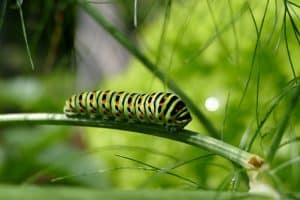 It appears in spring, until early autumn. It mainly attacks radishes, turnips and cabbages.
It appears in spring, until early autumn. It mainly attacks radishes, turnips and cabbages.
We can identify it by the black dots they have. The larvae are gray in color, tending to green. With three yellow lines that stand out.
It is important to detect the youngest larvae and eliminate them. Otherwise, they can become a serious problem.
We can also identify the adult specimen as a white butterfly. They fly over the cabbage fields.
We will know that this plague is attacking our crops by the bitten leaves of the cabbage.
Plusia (Autograph gamma)
It usually appears in late summer or early fall. It has a very characteristic way of moving and is green.
They mainly attack aubergines, courgettes, watermelons, tomatoes, melons, mint, basil and peppermint.
We can identify by looking at holes in the leaves of crops.
tomato borer caterpillar
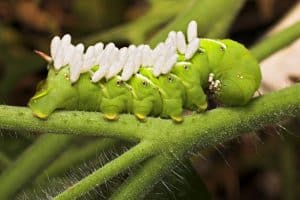 Here we have a strong enemy of the tomato.
Here we have a strong enemy of the tomato.
This caterpillar has a size of about 4 cm and is green in color. It can also attack corn, legumes or peppers.
To identify it, we can see that the youngest fruits of tomato plants have very characteristic holes and tunnels.
To stop this plague, it is important to prune the tomato plants often and identify the leaves and/or fruits that have been attacked.
What crops do caterpillars usually attack?
They attack most plants in our garden, especially broccoli, cauliflower, soybeans, lettuce, corn, sunflowers, alfalfa, wheat, and parsley.
How do we combat caterpillars?
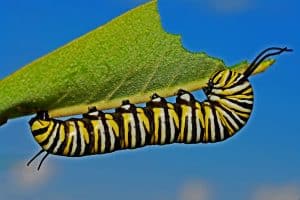 To prevent its appearance, it is recommended to keep the crops clean of weeds and remains of previous crops. In addition, the first stages of crop development must be monitored, in which irreversible damage can occur.
To prevent its appearance, it is recommended to keep the crops clean of weeds and remains of previous crops. In addition, the first stages of crop development must be monitored, in which irreversible damage can occur.
Another form of prevention is to place netting around the crops, as well as pheromone traps and light traps.
To control them, we can use water with biodegradable soap and garlic and chili extract. This mixture is applied very early in the morning or in the afternoon when the plants no longer receive the sun’s rays.
They can also be removed by hand, quickly and easily. In strong attacks it is convenient to eliminate and destroy the lower leaves of the plant.
Some natural enemies of the larvae are the lacewing and the bacterium Bacillus thuringiensis.

![Photo of The Dieffenbachia: [Characteristics, Planting, Care, Irrigation and Substrate]](https://www.complete-gardening.com/wp-content/uploads/2022/08/the-dieffenbachia-characteristics-planting-care-irrigation-and-substrate-390x220.png)
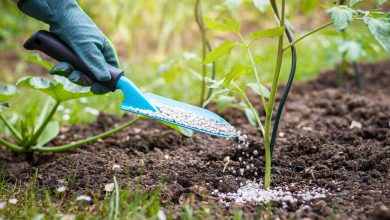
![Photo of How to germinate Palm Tree Seeds: [Time, Steps and Planting]](https://www.complete-gardening.com/wp-content/uploads/2022/08/how-to-germinate-palm-tree-seeds-time-steps-and-planting-390x220.jpg)
